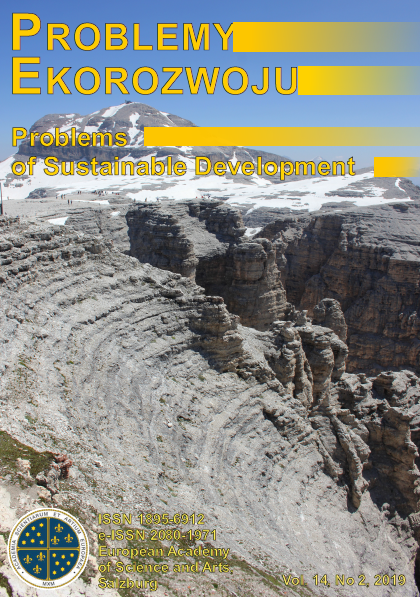Ocena zrównoważonego rozwoju za pomocą analizy skupień i analizy głównych składników
Magdaléna Drastichová*, Peter Filzmoser**
*VŠB-Technical University of Ostrava, Faculty of Economics, Department of Regional and Environmental Economics, Sokolská 33, 701 21 Ostrava, Czech Republic
E-mail: magdalena.drastichova@vsb.cz
**Vienna University of Technology, Institute of Statistics and Mathematical Methods in Economics, Wiedner Hauptstrasse 8-10, 1040 Vienna, Austria
E-mail: peter.filzmoser@tuwien.ac.at
Abstract
The European Union (EU) Sustainable Development Goals (SDG) indicator set replaced the EU Sustainable Development Strategy (SDS) in 2017. The selected indicators of this set were chosen for the analysis to classify the sample of the 28 EU countries along with Norway according to their performance in sustainability. In the selection of indicators, priority was given to the indicators reflecting the social dimension of SD, along with important representatives of the economic, ecological and institutional dimensions of SD generally. Hierarchical Cluster Analysis (HCA) and Principal Component Analysis (PCA) were applied to the data of 12 indicators in the period 2012- 2016. By means of the HCA, four clusters were created in each year of the period 2012-2016 using the indicator values of particular years and then using all the indicator values in all the monitored years for the general assignment of countries to particular clusters. According to changes in the assignment to particular clusters over the years, the sustainability of development and the path of SD in the examined countries are assessed. As regards the core countries of each cluster, cluster 1 includes the most developed EU countries and is thus evaluated as the best performing cluster. Cluster 2 including the least developed EU countries is evaluated as the worst performing cluster. Cluster 3 predominantly includes the transitive economies and it is evaluated as the second best performing cluster according to the indicators applied. Cluster 4 containing the Southern countries is assessed as the second worst performing cluster. From the shifts of countries that occurred between the years, the shift of Ireland from cluster 3 to cluster 1 in 2013 must be emphasised as the move towards higher sustainability. The shift of Slovakia and Hungary from cluster 2 to cluster 3 in 2013 is also evaluated as progress towards higher sustainability.
Key words: European Union (EU), Hierarchical Cluster Analysis (HCA), Principal Component Analysis (PCA), Sustainable Development (SD), Sustainable Development Goals (SDGs), JEL Classification: Q01, Q50, Q51, Q54, Q56
Streszczenie
W Unii Europejskiej w 2017 r. Cele zrównoważonego rozwoju zastąpiły dotychczasową Strategię zrównoważonego rozwoju. W tej pracy wybrane wskaźniki odnoszące się do nowych Celów zrównoważonego rozwoju stanowią podstawę klasyfikacji 28 krajów Wspólnoty oraz Norwegii. Wśród tych wskaźników priorytetowo potraktowano te odnoszące się do wymiaru społecznego zrównoważonego rozwoju, uzupełniając dyskusję o podstawowe wskaźniki ekonomiczne, ekologiczne i instytucjonalne. Przeanalizowano okres obejmujący lata 2012-2016. Wobec wybranych 12 wskaźników zastosowano hierarchiczną analizę skupień i analizę głównych składników. Utworzono cztery klastry w ramach każdego roku z analizowanego okresu, określając wartości wskaźników dla poszczególnych lat, a następnie określenie wszystkich wartości wskaźników dla wszystkich monitorowanych lat umożliwiło przypisanie krajów do poszczególnych klastrów. Określenie zmian w przypisaniu do poszczególnych klastrów na przestrzeni lat umożliwiło ocenę zrównoważoności rozwoju i określenie ścieżki zrównoważonego rozwoju badanych krajów. Jeśli chodzi o główne kraje każdego klastra, to klaster 1 obejmuje najbardziej rozwinięte kraje UE i dlatego jest oceniany jako klaster, który osiąga najlepsze wyniki. Klaster 2 uwzględnia najsłabiej rozwinięte kraje i oceniony jest jako ten, który osiąga najgorsze wyniki. Klaster 3 obejmuje głównie gospodarki znajdujące się w okresie przejściowym i jest oceniany jako drugi osiągający najlepsze wyniki. Klaster 4 obejmuje kraje Południa i jest oceniany jako drugi osiągający najgorsze wyniki. Uwzględniając zmiany jakie zaszły w okresie kolejnych lat, należy podkreślić przesunięcie Irlandii z klastra 3 do klastra 1 w 2013 r., co oznacza ruch w kierunku większej zrównoważoności. Tak samo należy ocenić przejście w tym samym roku Słowacji i Węgier z klastra 2 do klastra 3.
Słowa kluczowe: Unia Europejska, hierarchiczna analiza skupień, analiza głównych wskaźników, rozwój zrównoważony, cele zrównoważonego rozwoju
Problemy Ekorozwoju 14(2)2019: 7-24
